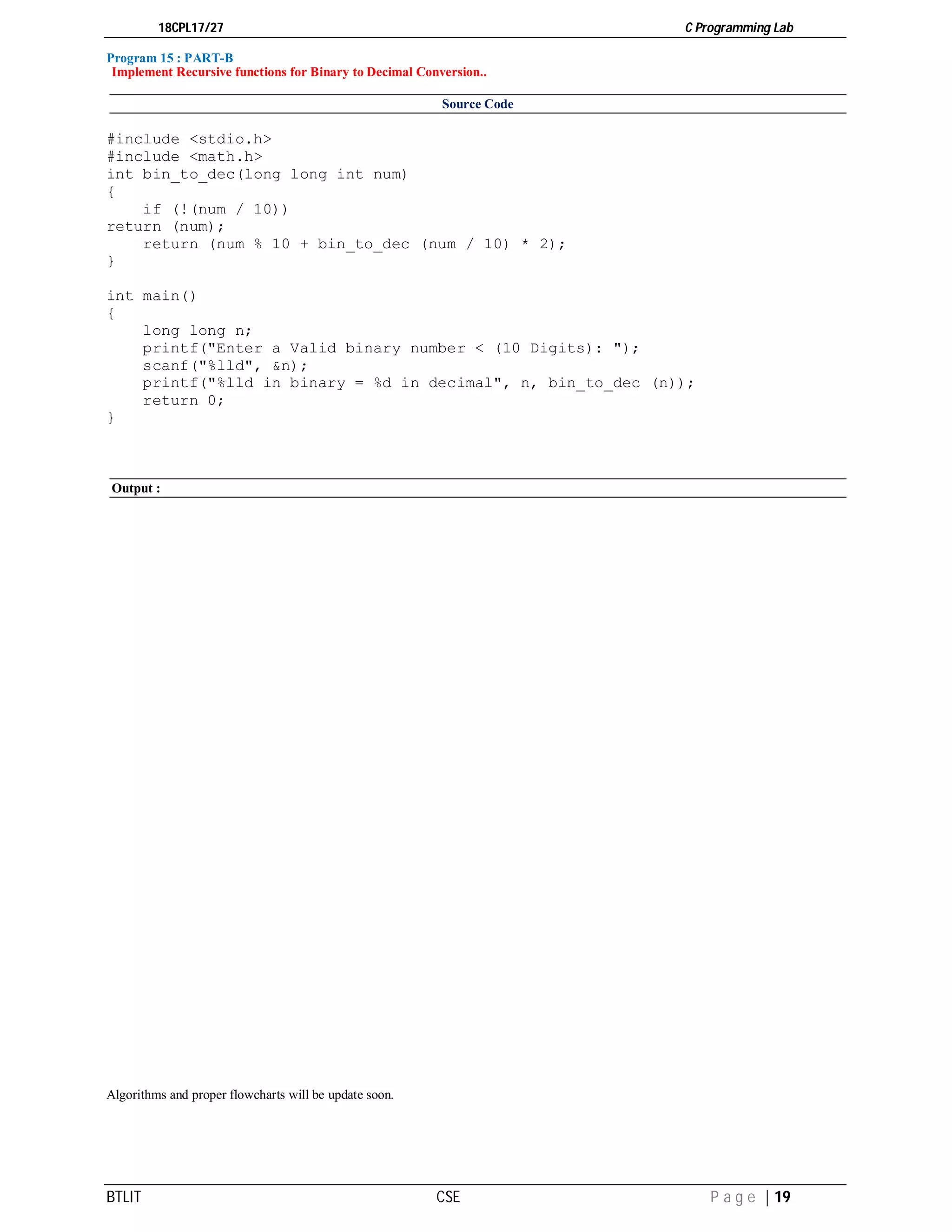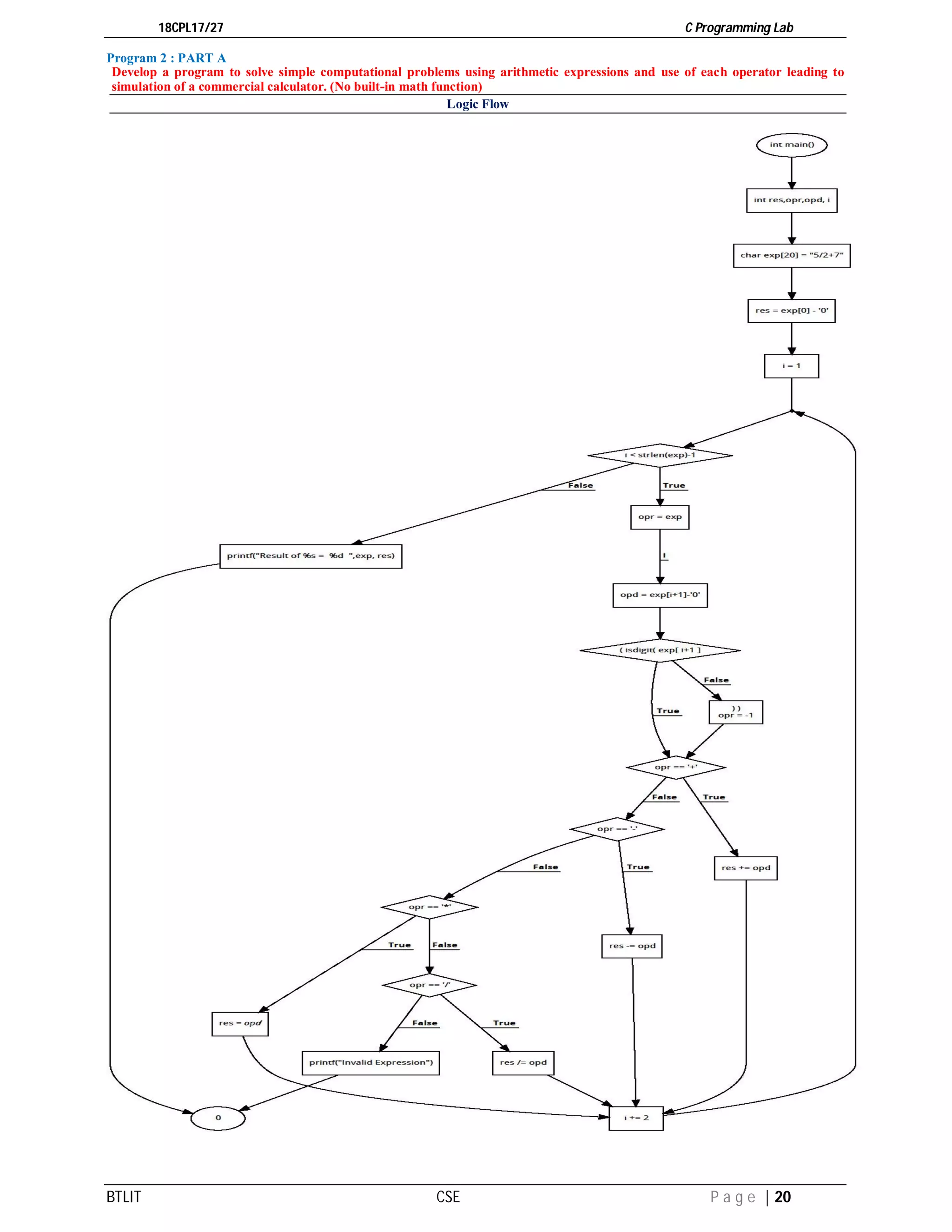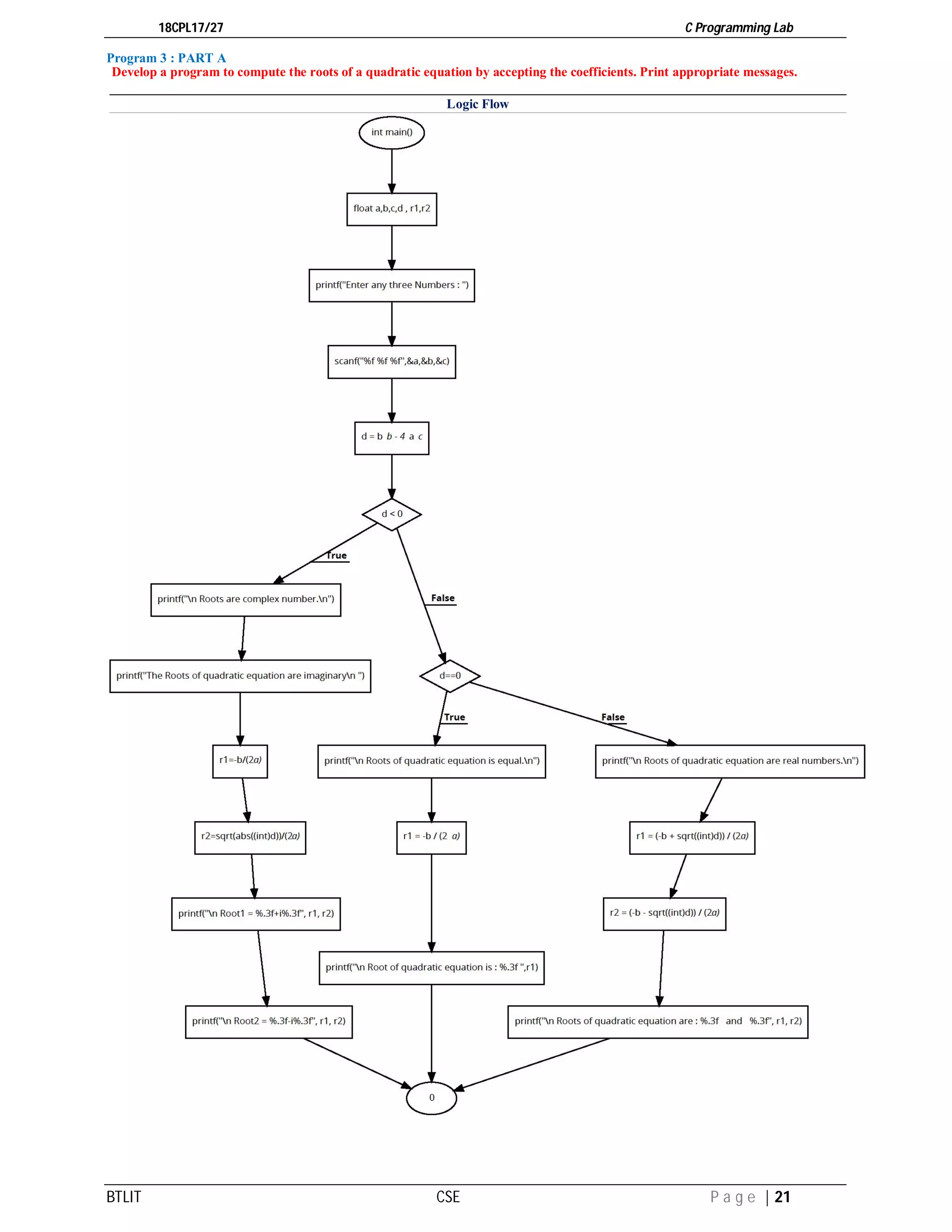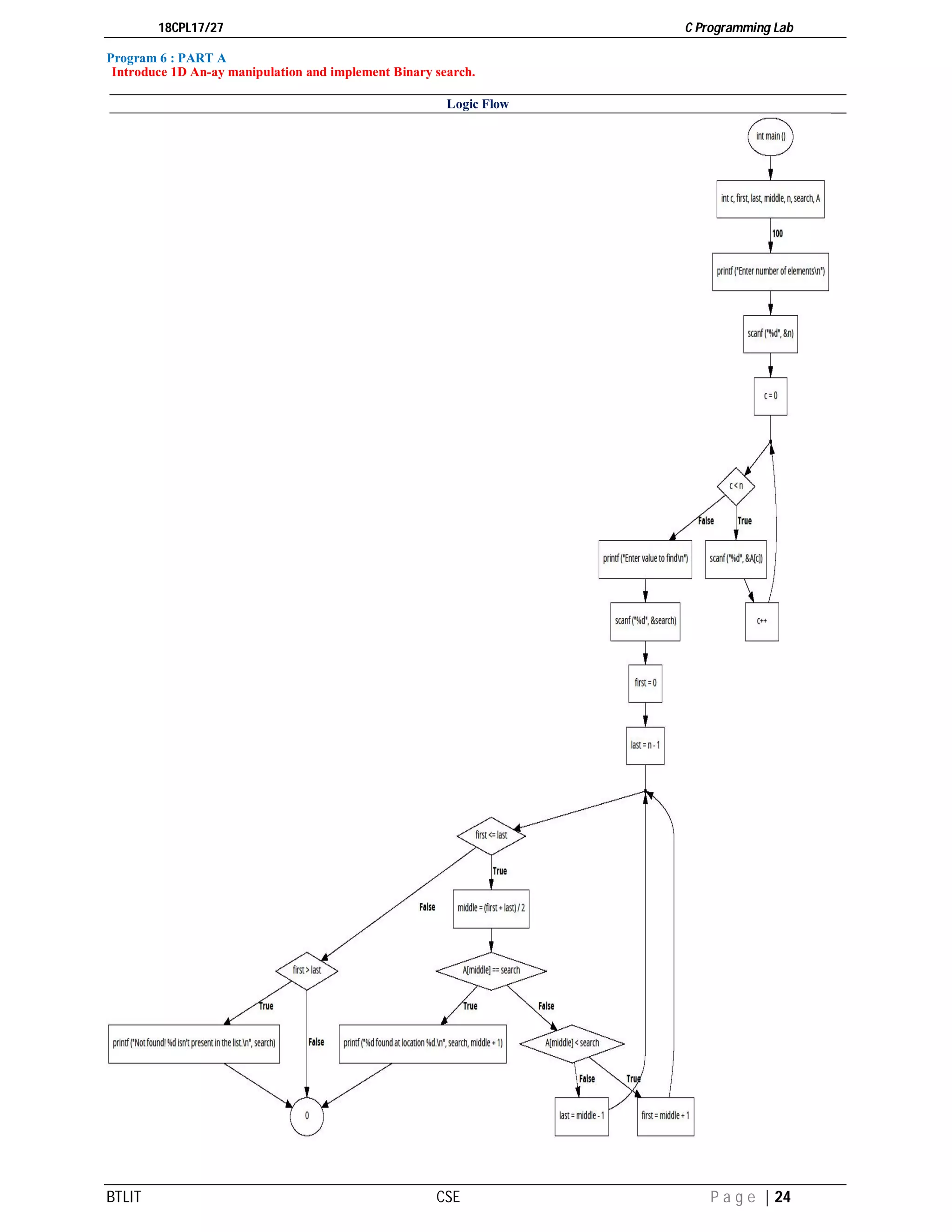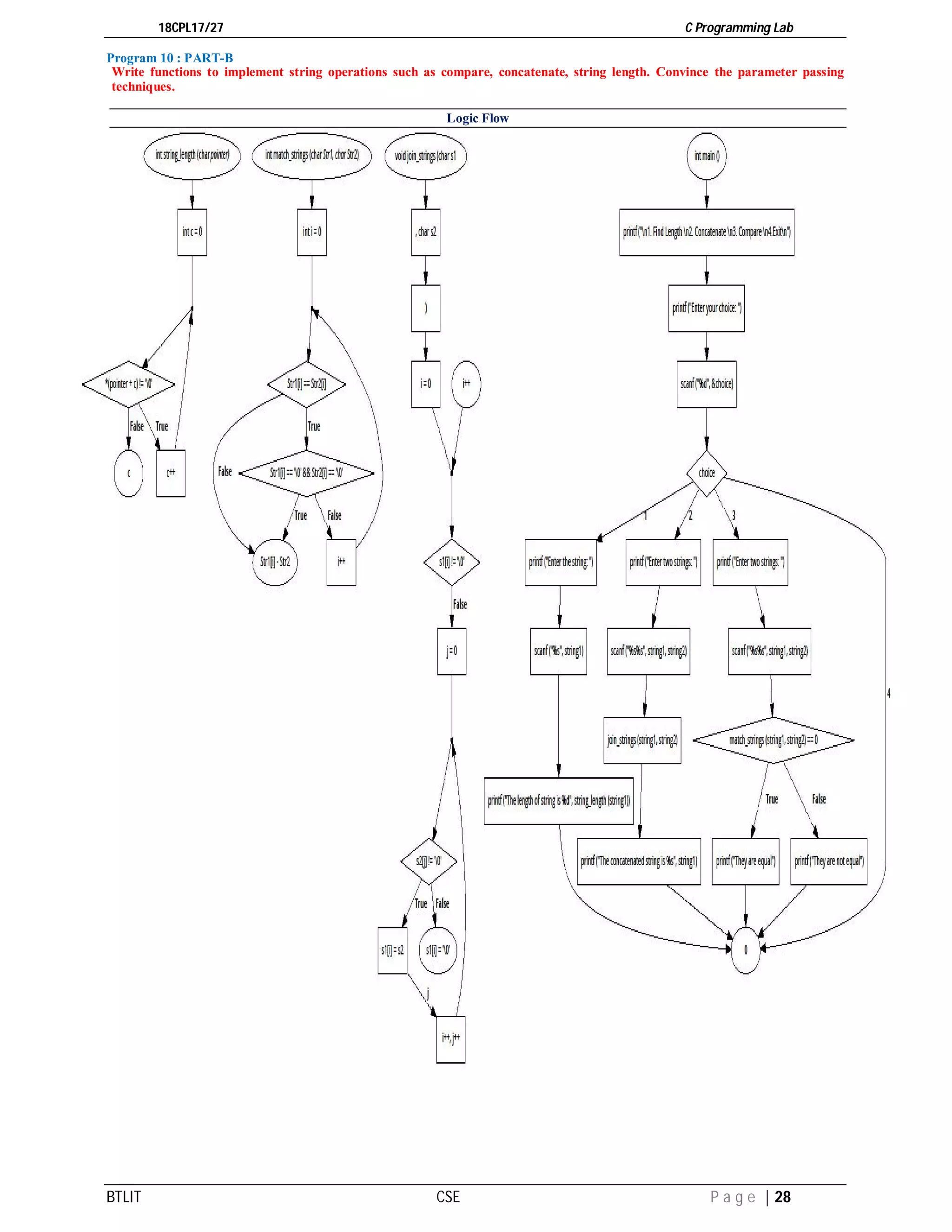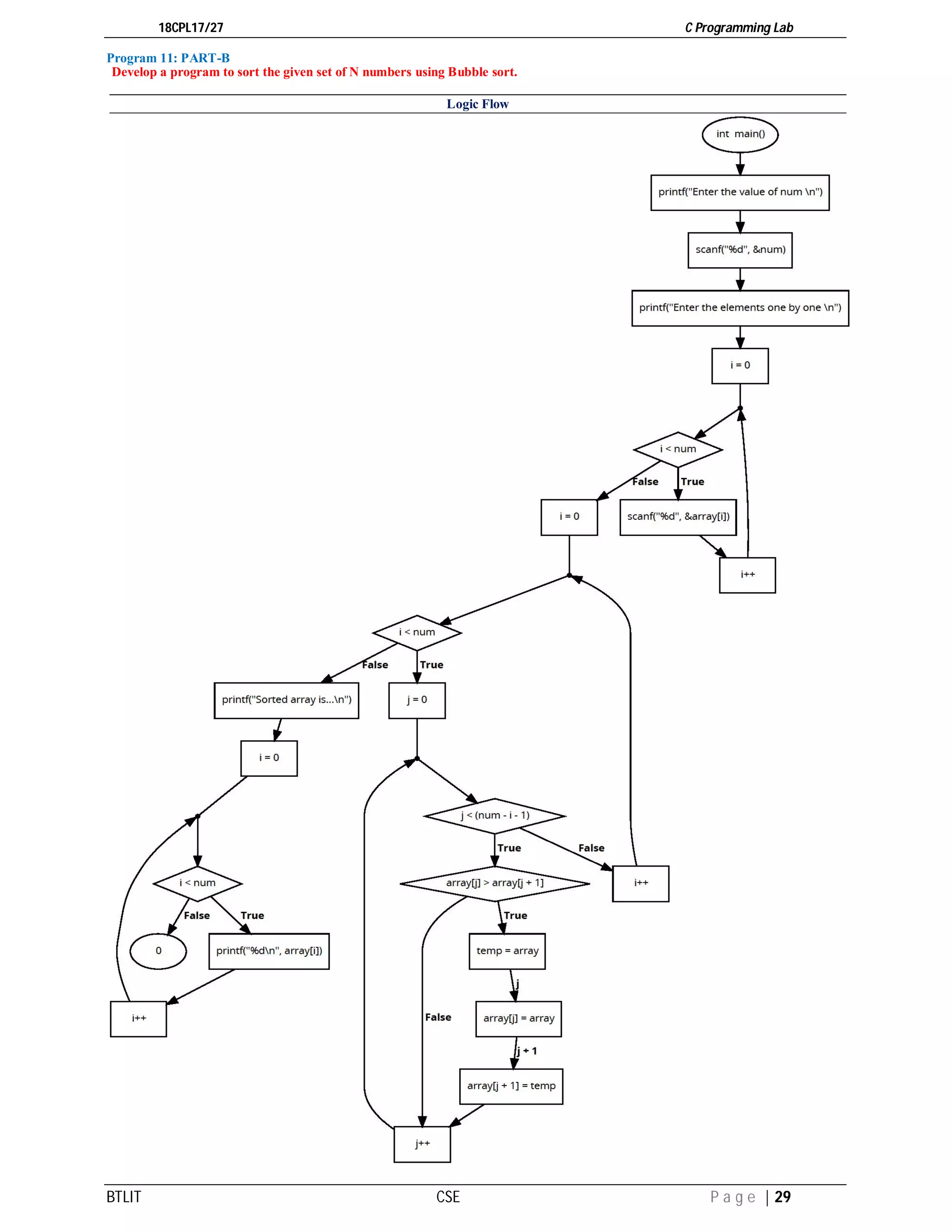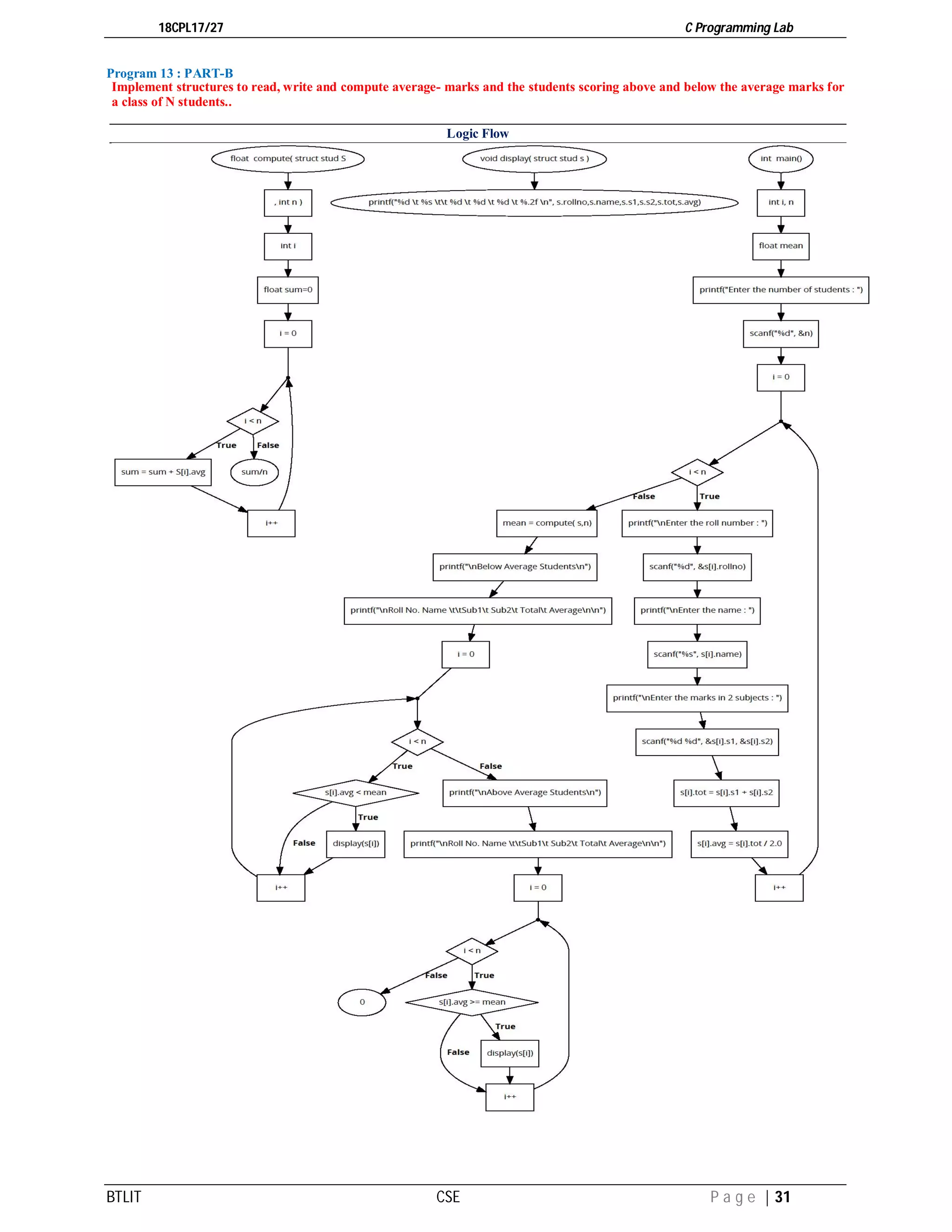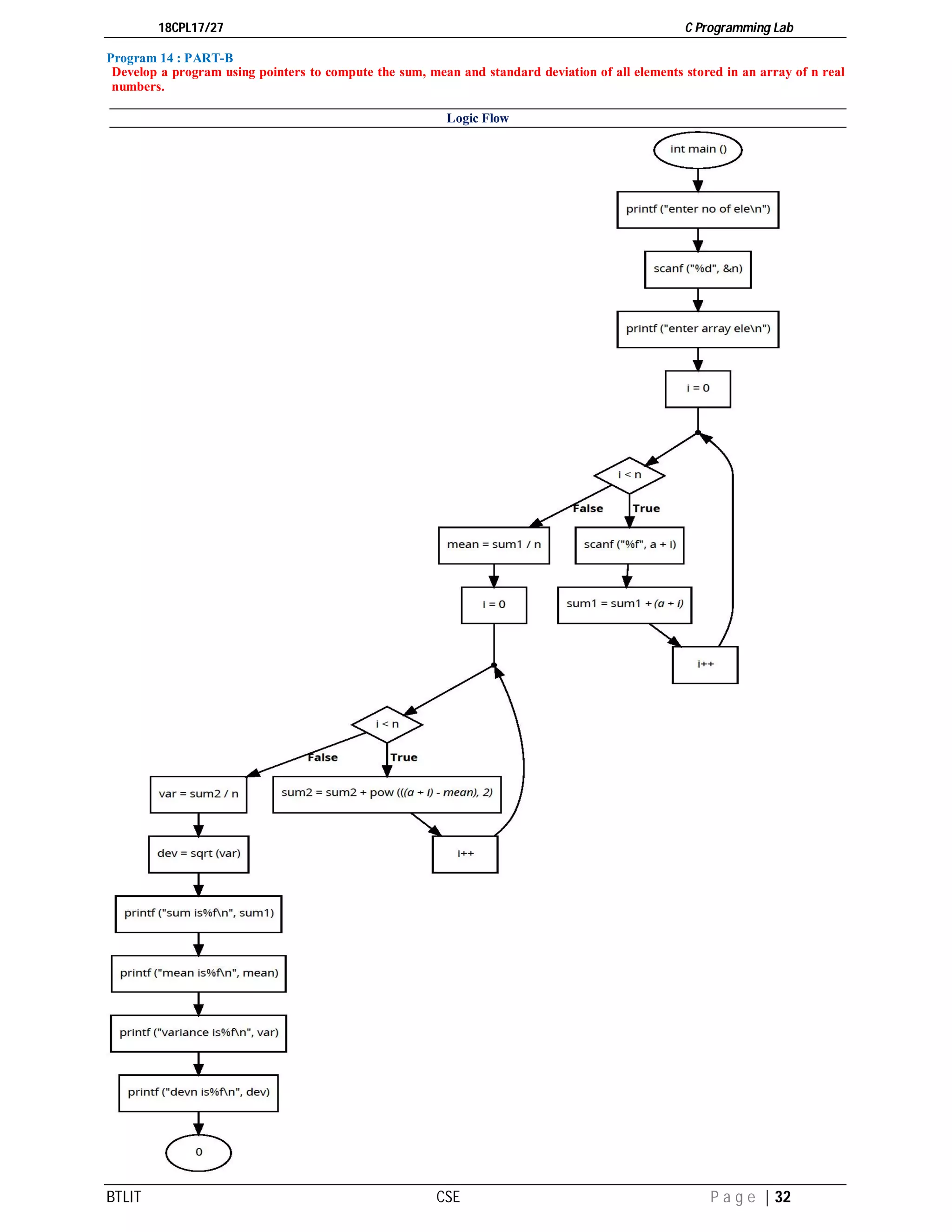This document appears to be a laboratory manual for a C programming course. It includes 15 experiments covering topics like arithmetic expressions, quadratic equations, strings, arrays, structures, pointers, and recursion. For each experiment, students are instructed to write algorithms, flowcharts, and C code to solve programming problems. They then test and debug their code. Marks are awarded for the procedure, execution, and viva voce of each experiment.

![C PROGRAMMING LABORATORY SYLLABUS
Semester : I/II CIE Marks : 40 SEE Marks : 60 Exam Hours: 03
Course Code : 18CPL17 Credits : 01 Teaching Hours/week (L:T:P): 0:0:2
Course Learning Objectives:
This course (18CPL17/27) will enable students to:
Write flowcharts, algorithms and programs.
Familiarize the processes of debugging and execution.
Implement basics of C programming language.
Illustrate solutions to the laboratory programs.
Descriptions (if any):
The laboratoryshouldbe precededorfollowedbyatutorialtoexplaintheapproach or algorithm being implemented or implemented for the problems given.
Note that experiment 1 is mandatory and written in the joumal.
Questions related withexperiment 1, needto be askedduring viva-voce for all experiments.
Everyexperiment shouldhave algorithmandflowchart be writtenbeforewriting the program.
Code should be traced using minimum two test cases which should berecorded.
It is preferred to implement using Linux and GCC.
Laboratory Programs:
1. Familiarization with computer hardware and programming environment, concept of naming the program files, storing, compilation,
execution and debugging, taking any simple C- code. [Not included in the Lab Exam ]
PART A
2. Develop a program to solve simple computational problems using arithmetic expressions and use of each operator leading to simulation of
a commercial calculator. (No built-in math function)
3. Develop a program to compute the roots of a quadratic equation by accepting the coefficients. Print appropriate messages.
4. Develop a program to find the reverse of a positive integer and check for palindrome or not. Display appropriate messages.
5. An electricity board charges the following rates for the use of electricity: for the first 200 units 80 paisa per unit: for the next 100 units 90
paisa per unit: beyond 300 units Rs 1 per unit. All users are charged a minimum of Rs. 100 as meter charge. If the total amount is more
than Rs 400, then an additional surcharge of 15% of total amount is charged. Write a program to read the name of the user, number of
units consumed and print out the charges.
6. Introduce 1D An-
ay manipulation and implement Binary search.
7. Implement using functions to check whether the given number is prime and display appropriate messages. (No built-in math function)
PART B
8. Develop a program to introduce 2D Array manipulation and implement Matrix multiplication and ensure the rules of multiplication are
checked.
9. Develop a Program to compute Sin(x) using Taylor series approximation. Compare your result with the built- in Library function. Print
both the results with appropriate messages.
10. Write functions to implement string operations such as compare, concatenate, string length. Convince the parameter passing techniques.
11. Develop a program to sort the given set of N numbers using Bubble sort.
12. Develop a program to find the square root of a given number N and execute for all possible inputs with appropriate messages.
Note: Don't use library function sqrt(n).
13. Implement structures to read, write and compute average- marks and the students scoring above and below the average marks for a class
of N students.
14. Develop a program using pointers to compute the sum, mean and standard deviation of all elements stored in an array of n real numbers.
15. Implement Recursive functions for Binary to Decimal Conversion.
Laboratory Outcomes:
The student should be able to:
Write algorithms, flowcharts and program for simple problems.
Correct syntax and logical errors to execute a program.
Write iterative and wherever possible recursive programs.
Demonstrate use of functions, arrays, strings, structures and pointers in problem solving.
Conduct of Practical Examination:
All laboratory experiments, excluding the first, are to be included for practical examination.
Experiment distribution
o For questions having only one part: Students are allowed to pick one experiment from the lot and are given equal opportunity.
o For questions having part A and B: Students are allowed to pick one experiment from part A and one experiment from part B and are given equal
opportunity.
Strictly follow the instructions as printed on the cover page of answer script for breakup of marks
Change of experiment is allowed only once and marks allotted for procedure part to be made zero.
Marks Distribution (Subjected to change in accordance with university regulations)
a) For questions having only one part — Procedure + Execution + Viva-Voce: 15+70+15 =100 Marks
b) For questions having part A and B
i. Part A— Procedure + Execution + Viva = 4 + 21 + 5 = 30 Marks
ii. Part B — Procedure + Execution + Viva = 10 + 49 + 11 = 70 Marks](https://image.slidesharecdn.com/vtucpllabmanual18cpl17-180827070936/75/C-Programming-Lab-manual-18CPL17-2-2048.jpg)
![INDEX
Exp
No
Date LaboratoryProgramsinShort
ObtainedMarks
A
/F
P E V Signature
1
PART–A 2 2 21 5
2
3
4
5
6
7
PART–B 4 6 49 11
8
9
10
11
12
13
14
15
A–Algorithms F–Flowchart P–Procedure E–Execution V–Viva
AftertheeachexperimentexecutionstudentmustgetsignaturebytheInchargefacultywithdate.
Thefacultyastoentertheobtainmarksfortheeachexperiment. MaximummarksgivenforPart-A&Part-B
Note:
1. Everyexperiment shouldhave algorithmandflowchart be writtenbeforewriting the program.
2. Code should be traced using minimum two test cases which should berecorded.
ClassInternalEvaluationMarks (FilledbyInchargeFaculty)
Part-A
Exp.No. 2 3 4 5 6 7 Total Average
(Total/6)
Signature
MaxMarks 30 30 30 30 30 30 180
MarksObtain
Part-B
Exp.No. 8 9 10 11 12 13 14 15 Total Average
(Total/8)
Signature
MaxMarks 70 70 70 70 70 70 70 70 560
MarksObtain
CIEMarksObtained [ (Part-A+Part-B)x0.40]](https://image.slidesharecdn.com/vtucpllabmanual18cpl17-180827070936/75/C-Programming-Lab-manual-18CPL17-3-2048.jpg)
![18CPL17/27 C Programming Lab
Program – 1 : Familiarization with computer hardware and programming environment, concept of naming the program files, storing,
compilation, execution and debugging, taking any simple C- code. [Not included in the Lab Exam ]
Generally, the programs created using programming languages like C, C++, Java etc., are written
using high level language like English. But, computer cannot understand the high level language. It
can understand only low level language. So, the program written in high level language needs to be
converted into low level language to make it understandable for the computer. This conversion is
performed using either Interpreter or Compiler.
Popular programming languages like C, C++, Java etc., use compiler to convert high level language
instructions into low level language instructions. Compiler is a program that converts high level
language instructions into low level language instructions. Generally, compiler performs two
things, first it verifies the program errors, if errors are found, it returns list of errors otherwise it
converts the complete code into low level language.
To create and execute C programs in Windows Operating System, we need to install Turbo C
software. We use the following steps to create and execute C programs in Windows OS…
Step 1: Creating Source Code
Source code is a file with C programming instructions in high level language. To create source
code, we use any text editor to write the program instructions. The instructions written in the
source code must follow the C programming language rules. The following steps are used to create
source code file in Windows OS…
Click on Start button
Select Run
Type cmd and press Enter
Type cd c:TCbin in the command prompt and press Enter
Type TC press Enter
Click on File -> New in C Editor window
Type the program
Save it as FileName.c (Use shortcut key F2 to save)](https://image.slidesharecdn.com/vtucpllabmanual18cpl17-180827070936/75/C-Programming-Lab-manual-18CPL17-4-2048.jpg)
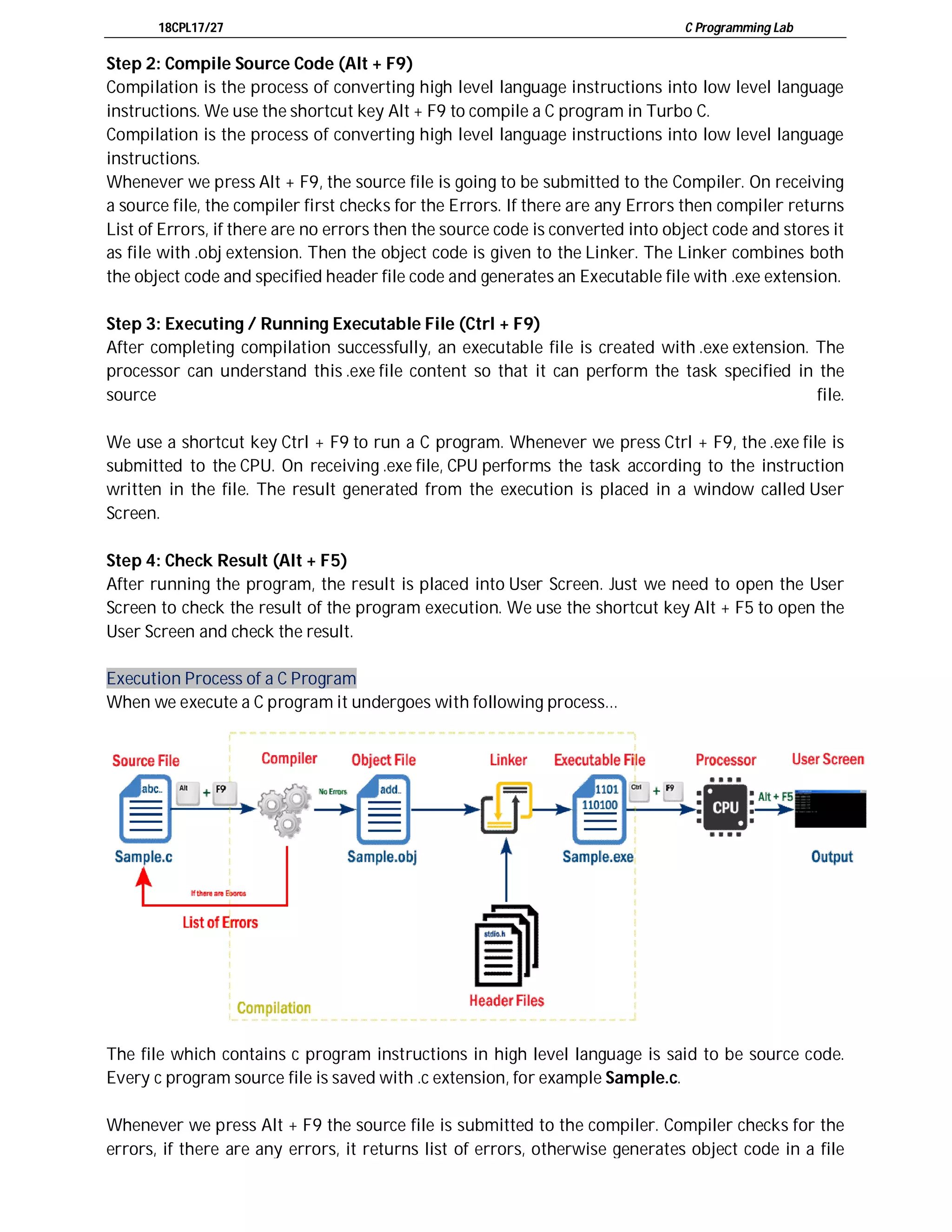
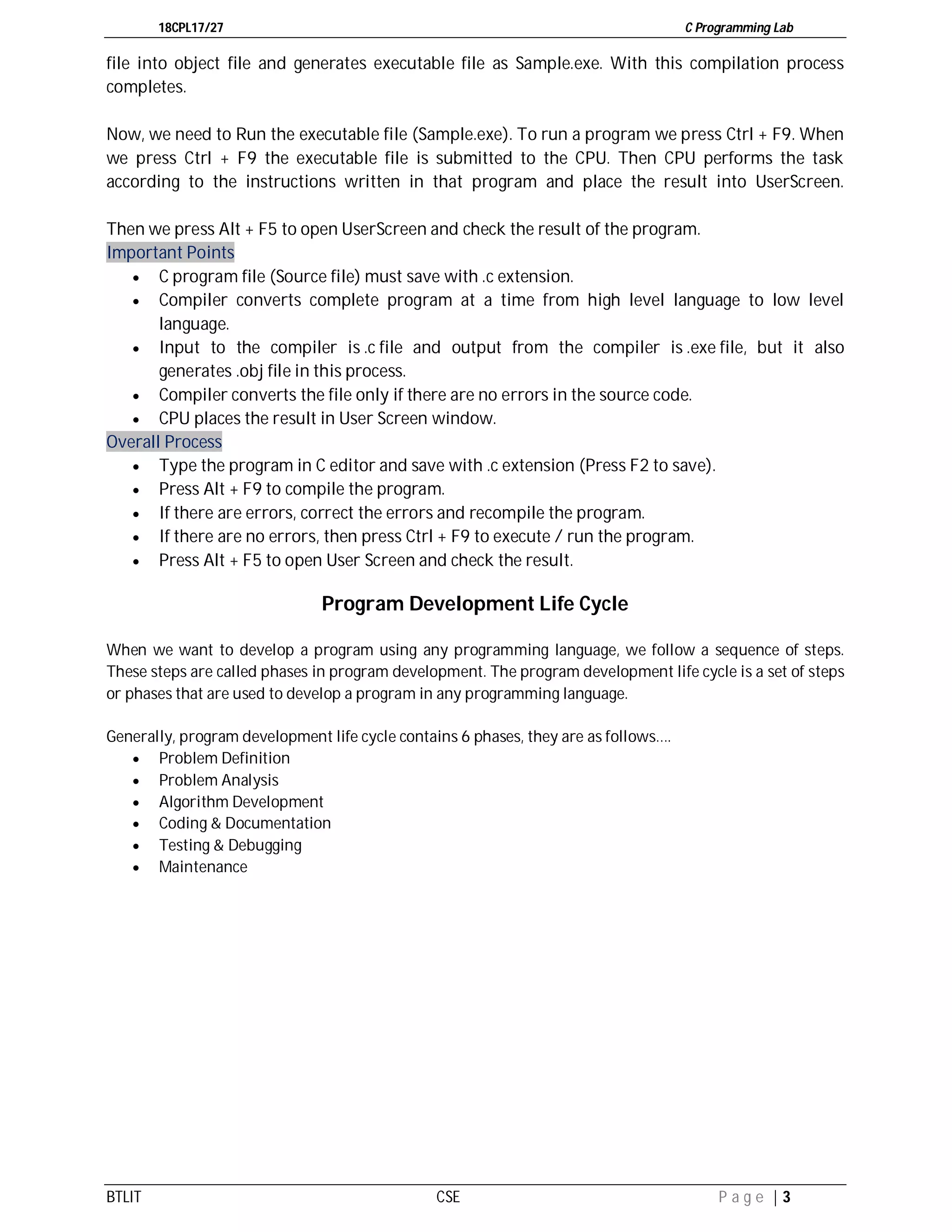
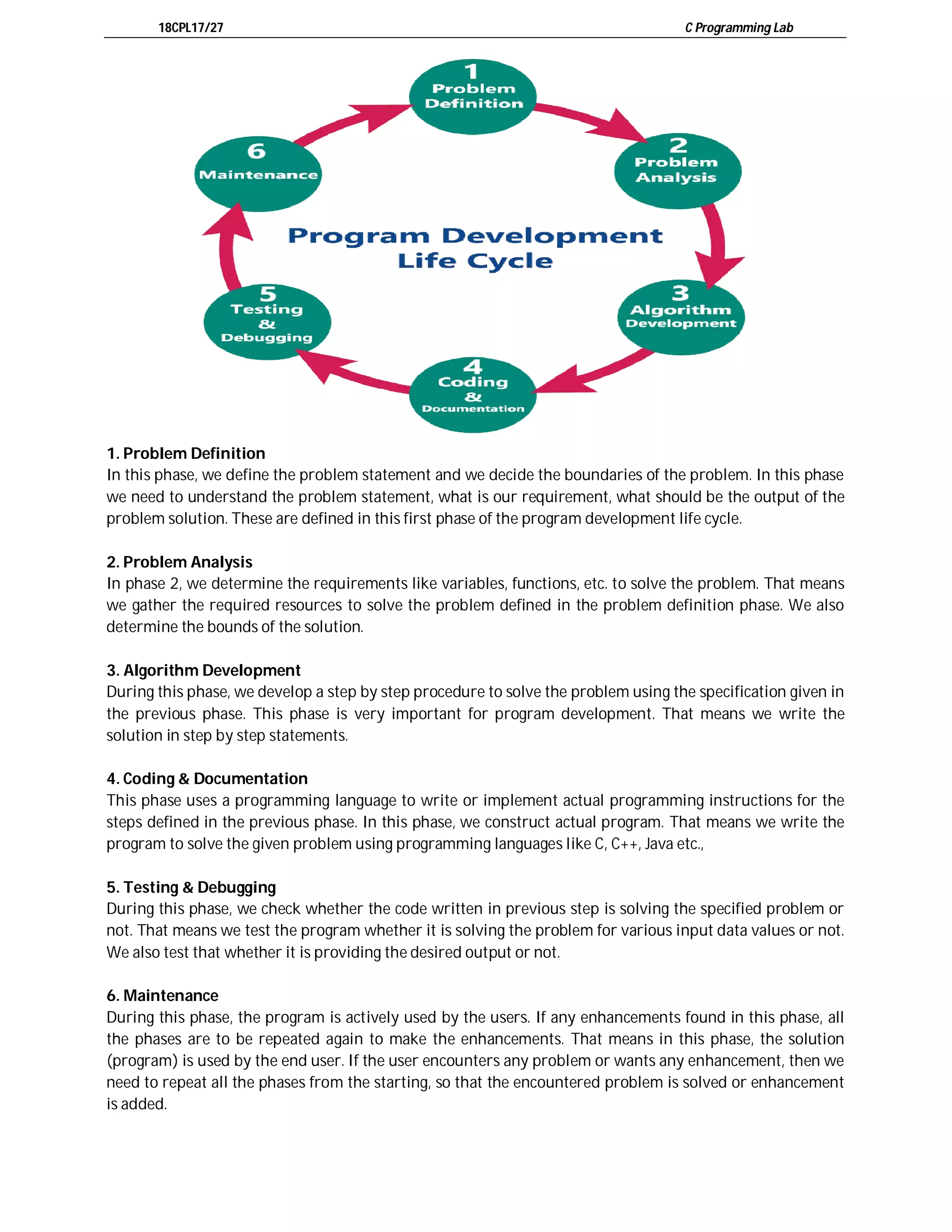
![18CPL17/27 C Programming Lab
BTLIT CSE P a g e | 5
Program 2 : PART A
Develop a program to solve simple computational problems using arithmetic expressions and use of each operator leading to
simulation of a commercial calculator. (No built-in math function)
Source Code
#include <stdio.h>
#include<strings.h>
#include<ctype.h>
int main()
{
int res,opr,opd, i;
char exp[20] = "5/2+7";
res = exp[0] - '0' ;
for ( i = 1; i < strlen(exp)-1; i += 2)
{
opr = exp[i];
opd = exp[i+1]-'0';
if ( !( isdigit( exp[ i+1 ] ) ) )
opr = -1;
if (opr == '+')
res += opd;
else if (opr == '-')
res -= opd;
else if (opr == '*')
res *= opd;
else if (opr == '/')
res /= opd;
else
{
printf("Invalid Expression");
return 0;
}
}
printf("Result of %s = %d ",exp, res);
return 0;
}
Output :](https://image.slidesharecdn.com/vtucpllabmanual18cpl17-180827070936/75/C-Programming-Lab-manual-18CPL17-8-2048.jpg)

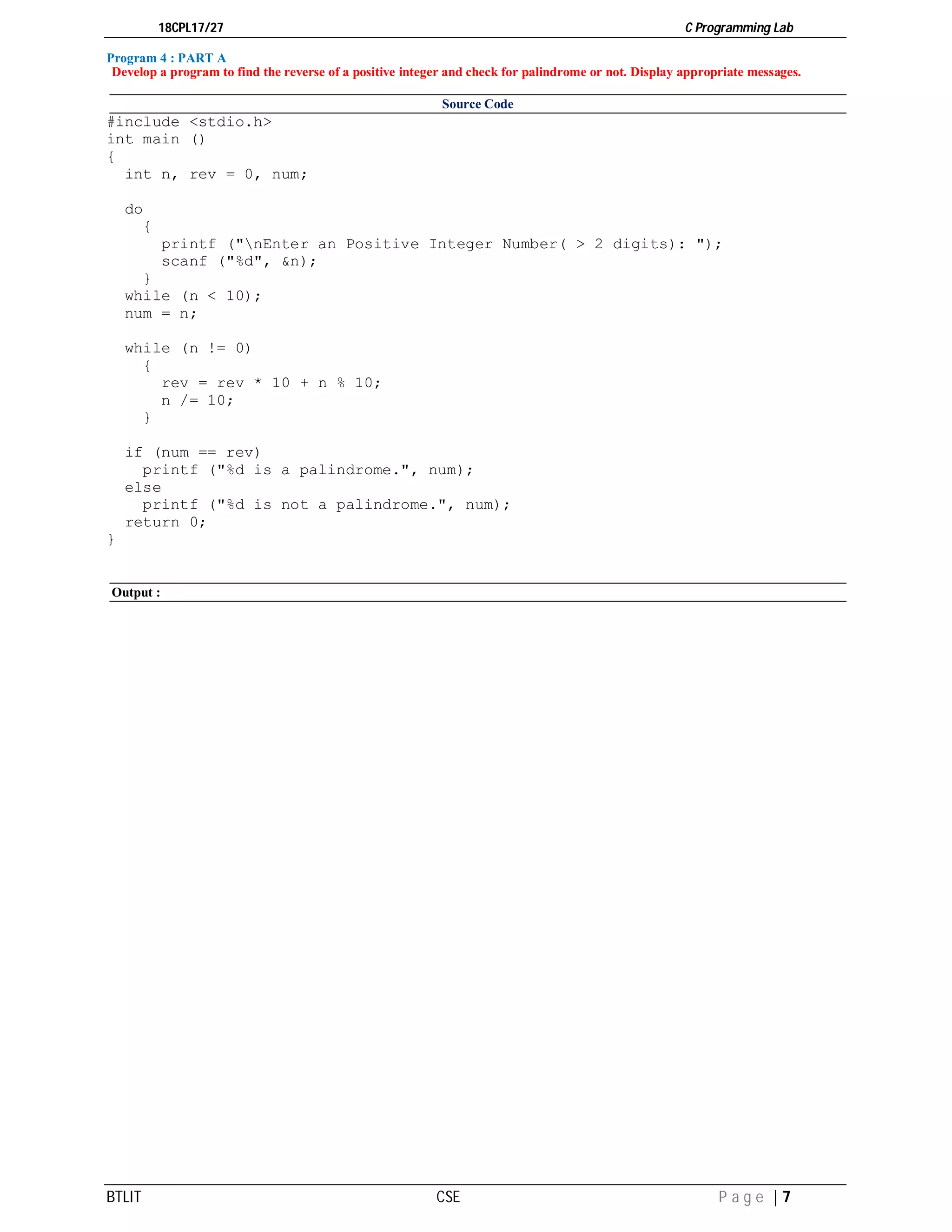
![18CPL17/27 C Programming Lab
BTLIT CSE P a g e | 8
Program 5 : PART A
An electricity board charges the following rates for the use of electricity: for the first 200 units 80 paisa per unit: for the next 100
units 90 paisa per unit: beyond 300 units Rs 1 per unit. All users are charged a minimum of Rs. 100 as meter charge. If the total
amount is more than Rs 400, then an additional surcharge of 15% of total amount is charged. Write a program to read the name
of the user, number of units consumed and print out the charges.
Source Code
#include <stdio.h>
int main ()
{
char name[20];
float unit, amount, scharge = 0.0;
printf ("Enter your name & unit Consumed(>0):");
scanf ("%s %f", name, &unit);
if (unit <= 200)
amount = unit * .80;
else if (unit <= 300)
amount = (unit - 200) * 0.90 + 160;
else if (unit > 300)
amount = (unit - 300) * 1 + 250;
if (amount > 400)
scharge = amount * 0.15;
printf ("n__________________");
printf("nName : %s",name);
printf("nUnit Consumed: %.0f",unit);
printf ("n____________nAmount : %5.2f nSurcharge : %5.2f", amount,
scharge);
printf ("n__________________");
printf ("nAmount Due : %.2f ", amount + scharge);
return 0;
}
Output :](https://image.slidesharecdn.com/vtucpllabmanual18cpl17-180827070936/75/C-Programming-Lab-manual-18CPL17-11-2048.jpg)
![18CPL17/27 C Programming Lab
BTLIT CSE P a g e | 9
Program 6 : PART A
Introduce 1D An-ay manipulation and implement Binary search.
Source Code
#include <stdio.h>
int main ()
{
int c, first, last, middle, n, search, A[100];
printf ("Enter number of elementsn");
scanf ("%d", &n);
printf ("Enter %d integersn", n);
for (c = 0; c < n; c++)
scanf ("%d", &A[c]);
printf ("Enter value to findn");
scanf ("%d", &search);
first = 0;
last = n - 1;
while (first <= last)
{
middle = (first + last) / 2;
if (A[middle] == search)
{
printf ("%d found at location %d.n", search, middle + 1);
return 0;
}
else if (A[middle] < search)
first = middle + 1; //search in right most part
else
last = middle - 1; //search in left most part
}
if (first > last)
printf ("Not found! %d isn't present in the list.n", search);
return 0;
}
Output :](https://image.slidesharecdn.com/vtucpllabmanual18cpl17-180827070936/75/C-Programming-Lab-manual-18CPL17-12-2048.jpg)

![18CPL17/27 C Programming Lab
BTLIT CSE P a g e | 11
Program 8 : PART- B
Develop a program to introduce 2D Array manipulation and implement Matrix multiplication and ensure the rules of
multiplication are checked.
Source Code
#include <stdio.h>
int main()
{
printf("Enter number of rows and columns of first matrixn");
scanf("%d%d", &m, &n);
printf("Enter number of rows and columns of second matrixn");
scanf("%d%d", &p, &q);
if (n != p)
{
printf("The matrices can't be multiplied with each other.n");
printf("Error! column of first matrix not equal to row of second.nn");
return 0;
}
printf("Enter elements of first matrixn");
for (c = 0; c < m; c++)
for (d = 0; d < n; d++)
scanf("%d", &first[c][d]);
printf("Enter elements of second matrixn");
for (c = 0; c < p; c++)
for (d = 0; d < q; d++)
scanf("%d", &second[c][d]);
for (c = 0; c < m; c++)
{
for (d = 0; d < q; d++)
{
sum = 0;
for (k = 0; k < p; k++)
{
sum = sum + first[c][k]*second[k][d];
}
multiply[c][d] = sum;
}
}
printf("Product of the matrices:n");
for (c = 0; c < m; c++) {
for (d = 0; d < q; d++)
printf("%dt", multiply[c][d]);
printf("n");
}
return 0;
}
Output :](https://image.slidesharecdn.com/vtucpllabmanual18cpl17-180827070936/75/C-Programming-Lab-manual-18CPL17-14-2048.jpg)

![18CPL17/27 C Programming Lab
BTLIT CSE P a g e | 13
Program 10 : PART-B
Write functions to implement string operations such as compare, concatenate, string length. Convince the parameter passing
techniques.
Source Code
#include<stdio.h>
int string_length (char *pointer)
{
int c = 0;
while (*(pointer + c) != '0')
c++;
return c;
}
int match_strings (char *Str1, char *Str2)
{
int i = 0;
while (Str1[i] == Str2[i])
{
if (Str1[i] == '0' && Str2[i] == '0')
break;
i++;
}
return Str1[i] - Str2[i];
}
void join_strings (char s1[], char s2[])
{
int i, j;
for (i = 0; s1[i] != '0'; i++);
for (j = 0; s2[j] != '0'; i++, j++)
{
s1[i] = s2[j];
}
s1[i] = '0';
}
int main ()
{
char string1[20], string2[20];
int choice;
printf ("n1. Find Length n2. Concatenate n3. Compare n4.Exitn");
printf ("Enter your choice: ");
scanf ("%d", &choice);
switch (choice)
{
case 1:
printf ("Enter the string: ");
scanf ("%s", string1);
printf ("The length of string is %d", string_length (string1));
break;
case 2:
printf ("Enter two strings: ");
scanf ("%s%s", string1, string2);
join_strings (string1, string2);
printf ("The concatenated string is %s", string1);
break;](https://image.slidesharecdn.com/vtucpllabmanual18cpl17-180827070936/75/C-Programming-Lab-manual-18CPL17-16-2048.jpg)
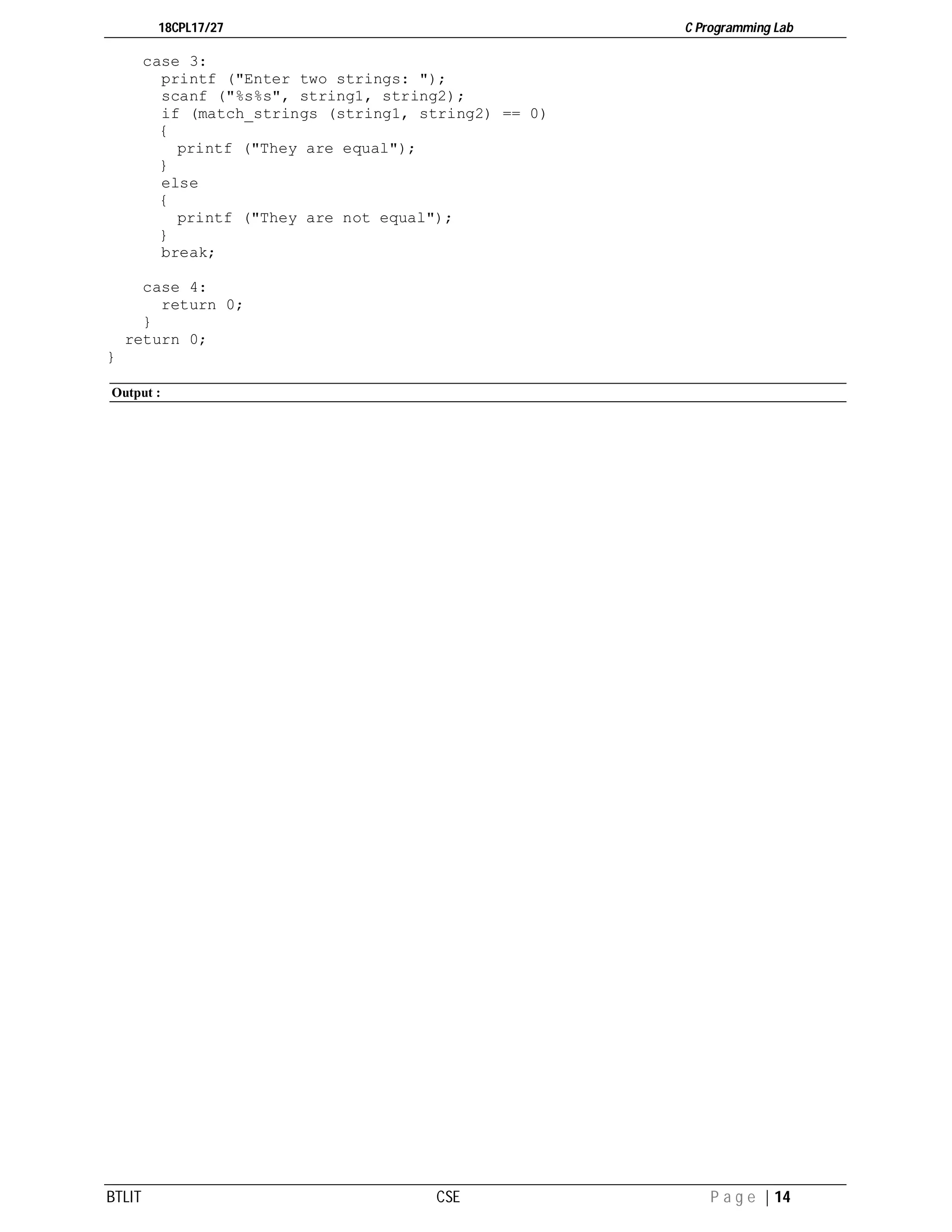
![18CPL17/27 C Programming Lab
BTLIT CSE P a g e | 15
Program 11: PART-B
Develop a program to sort the given set of N numbers using Bubble sort.
Source Code
#include <stdio.h>
#define MAXSIZE 10
void main()
{
int array[MAXSIZE];
int i, j, num, temp;
printf("Enter the value of num n");
scanf("%d", &num);
printf("Enter the elements one by one n");
for (i = 0; i < num; i++)
{
scanf("%d", &array[i]);
}
printf("Input array is n");
for (i = 0; i < num; i++)
{
printf("%dn", array[i]);
}
/* Bubble sorting begins */
for (i = 0; i < num; i++)
{
for (j = 0; j < (num - i - 1); j++)
{
if (array[j] > array[j + 1])
{
temp = array[j];
array[j] = array[j + 1];
array[j + 1] = temp;
}
}
}
printf("Sorted array is...n");
for (i = 0; i < num; i++)
{
printf("%dn", array[i]);
}
}
Output :](https://image.slidesharecdn.com/vtucpllabmanual18cpl17-180827070936/75/C-Programming-Lab-manual-18CPL17-18-2048.jpg)
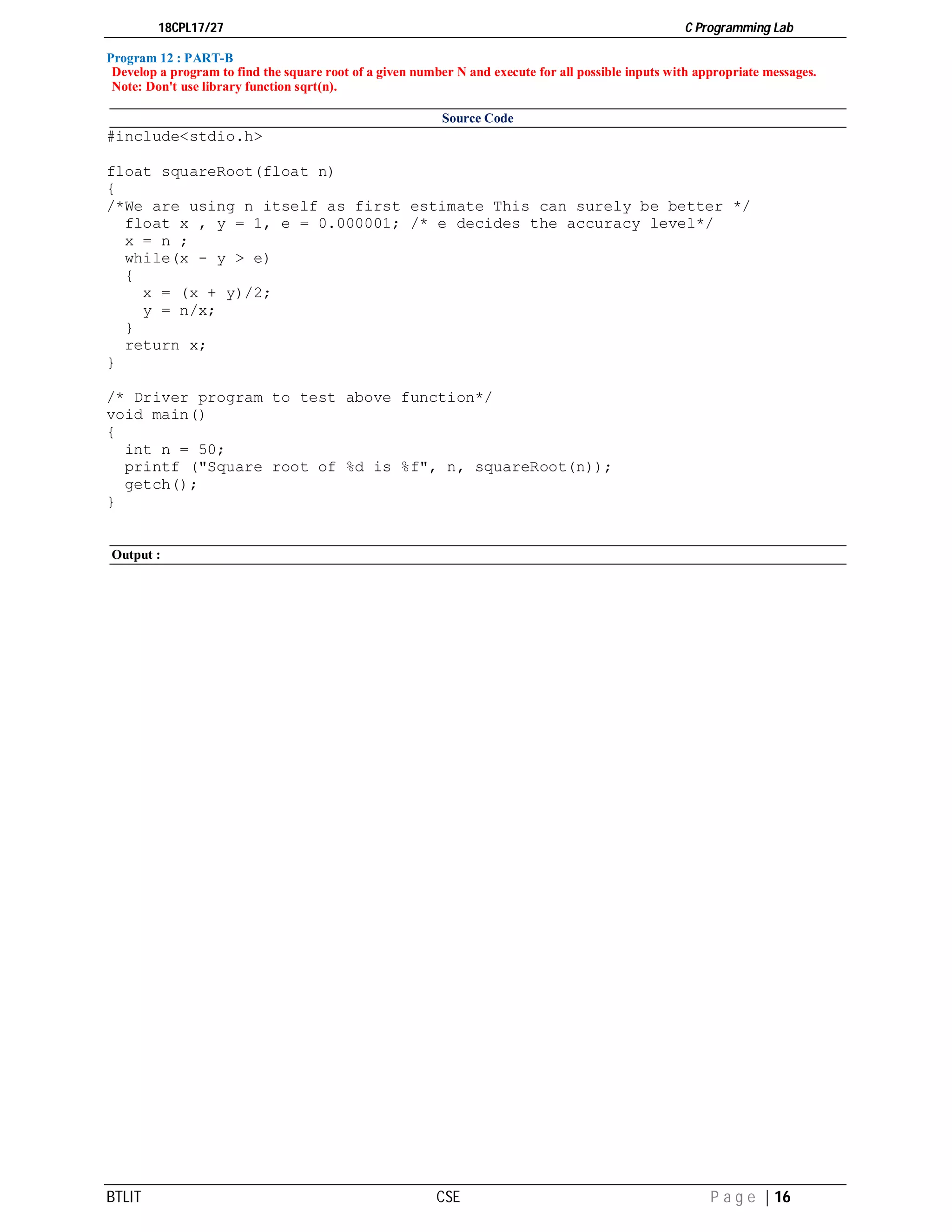
![18CPL17/27 C Programming Lab
BTLIT CSE P a g e | 17
Program 13 : PART-B
Implement structures to read, write and compute average- marks and the students scoring above and below the average marks for
a class of N students..
Source Code
#include<stdio.h>
struct stud
{
int rollno, s1, s2, tot ;
char name[10] ;
float avg ;
} s[10] ;
float compute( struct stud S[], int n )
{
int i;
float sum=0 ;
for ( i = 0 ; i < n ; i++ )
{
sum = sum + S[i].avg ;
}
return (sum/n);
}
void display( struct stud s )
{
printf("%d t %s tt %d t %d t %d t %.2f n", s.rollno,s.name,s.s1,s.s2,s.tot,s.avg);
}
int main()
{
int i, n ;
float mean;
printf("Enter the number of students : ") ;
scanf("%d", &n) ;
for(i = 0 ; i < n ; i++)
{
printf("nEnter the roll number : ") ;
scanf("%d", &s[i].rollno) ;
printf("nEnter the name : ") ;
scanf("%s", s[i].name) ;
printf("nEnter the marks in 2 subjects : ") ;
scanf("%d %d", &s[i].s1, &s[i].s2) ;
s[i].tot = s[i].s1 + s[i].s2 ;
s[i].avg = s[i].tot / 2.0 ;
}
mean = compute( s,n);
printf("nBelow Average Studentsn");
printf("nRoll No. Name ttSub1t Sub2t Totalt Averagenn") ;
for(i = 0 ; i < n ; i++)
{
if( s[i].avg < mean )
display(s[i]);
}
printf("nAbove Average Studentsn");
printf("nRoll No. Name ttSub1t Sub2t Totalt Averagenn") ;
for(i = 0 ; i < n ; i++)
{
if( s[i].avg >= mean )
display(s[i]);
}
return(0) ;
}
Output :](https://image.slidesharecdn.com/vtucpllabmanual18cpl17-180827070936/75/C-Programming-Lab-manual-18CPL17-20-2048.jpg)
![18CPL17/27 C Programming Lab
BTLIT CSE P a g e | 18
Program 14 : PART-B
Develop a program using pointers to compute the sum, mean and standard deviation of all elements stored in an array of n real
numbers.
Source Code
#include<stdio.h>
#include<math.h>
int main ()
{
float a[20], sum1 = 0, sum2 = 0, mean, var, dev;
int i, n;
printf ("enter no of elen");
scanf ("%d", &n);
printf ("enter array elen");
for (i = 0; i < n; i++)
{
scanf ("%f", a + i);
sum1 = sum1 + *(a + i);
}
mean = sum1 / n;
for (i = 0; i < n; i++)
{
sum2 = sum2 + pow ((*(a + i) - mean), 2);
}
var = sum2 / n;
dev = sqrt (var);
printf ("sum is%fn", sum1);
printf ("mean is%fn", mean);
printf ("variance is%fn", var);
printf ("devn is%fn", dev);
return 0;
}
Output :](https://image.slidesharecdn.com/vtucpllabmanual18cpl17-180827070936/75/C-Programming-Lab-manual-18CPL17-21-2048.jpg)
